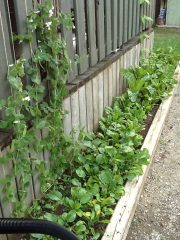
Wednesday, March 28th, 2018
It’s been years since we planted our first vegetable garden. In our first home, which was a new build, we had the opportunity to plant on a ‘blank canvas’ of a yard, and it was terrific. As our family grew, we moved north, out of Scarborough in favour of an out-of-town property with lots of trees and yard. That home included a massive vegetable garden all tilled and waiting for us, and it taught us many lessons including the benefit of scaling the garden to match our workloads.
Actually, location is a very important factor when considering a vegetable garden. In many cases, I expect the vegetable garden is an afterthought when the landscaping is being done. When we moved to our home in Elora, there was no vegetable garden space. In fact, where our vegetable beds are now – there were bushes, flagstone and a whole lot of pea gravel. I’m sure many would have looked at the flagstone and reconsidered the location of the garden, we were committed to remaking that spot to a usable space. It was close to water sources (both the downspout and the outdoor tap, close to electricity, to the driveway (for soil delivery) to the side door and consequently the bathroom, for reasons you can imagine). It was also conveniently located close to the kitchen so that I could zip out a select some ripe vegetables and herbs for dinner.
We took the sun’s position into account. This spot gets morning sun, and while there is a bit of shade during mid-day, it also gets afternoon sun. We also looked at the slope of the property to make sure it wasn’t at the lowest part, creating a boggy existence. The soil quality wasn’t the best, but we knew that we could amend the soil as we developed the beds. All in all, it was the best location in the yard.

Through my day job, I have learned the importance of testing, and through our gardening experience, we have learned that we have to pace ourselves and our expectations. So, the plan was to start slow and see how the garden did. The first year’s task list was exhausting as we removed the flagstone, gravel and bushes, replacing it with a single vegetable bed.
In year two we removed the flower clematis from the narrow bed opposite to the vegetable garden and built it up so that we could plant peas, mint and beans there. I’m sure you can see where I’m going with this … the beds were about to multiply like rabbits!
In the years following this, we added raised framing so that we could quickly amend the soil and added small additional beds at the rate of one a year. We have incorporated perennial plants into many of these beds including berries, rhubarb, asparagus, sorrel, grape vines and a couple of small multi-variety apple and cherry trees.
Last year we added a little edible garden to the front lawn. As we have a smallish yard, we now find ourselves seeking creative methods to increase our growing space without eliminating the small “green space” we have left.
Well, stay tuned! This season we’ll be experimenting with straw-bale gardening, containers and vertical gardening methods, all geared to expanding our garden space, where no garden exists. We have some exciting varieties started along with plants that one might not have seen in a neighbourhood garden.
HOT TIP: When planning a vegetable bed, consider your arms reach and physical condition when deciding on the width of the bed. When we were younger, we spent many sore nights after a day of weeding. Now I opt for beds that are no wider than twice my arms reach, which ensures that I can weed the centre of the bed without over-reaching.